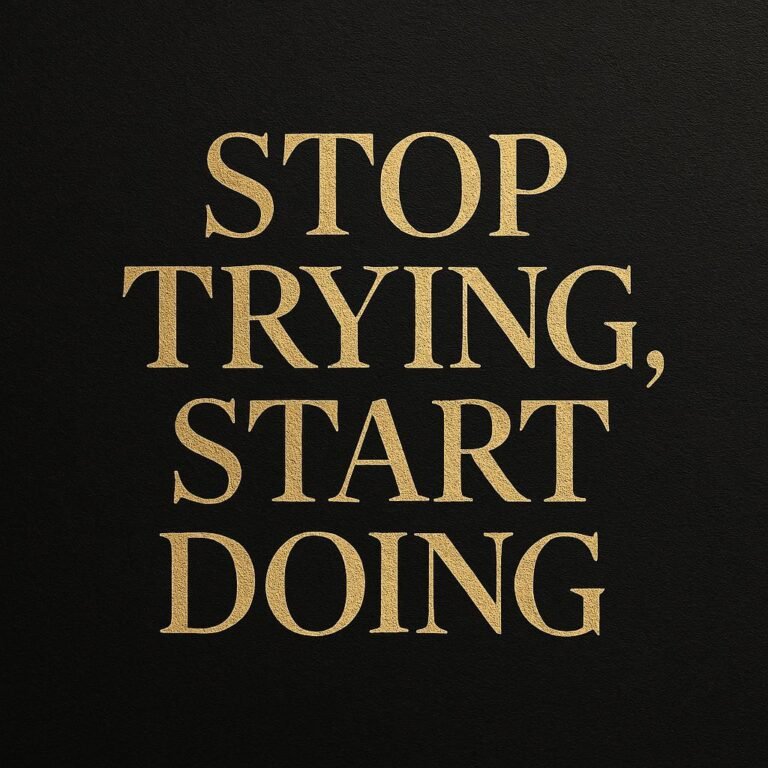
September 16, 2024
Coach G
1 Comment
Enough with simply trying! We’ve all heard the famous phrase, “Just do it,” popularized by Nike, and it resonates for a good reason. The act of trying, while seemingly positive and well-intentioned, often primes our minds to accept potential failure. When we say, “I’m trying” or “I’ll try,” we subtly create a mental backdoor, allowing ourselves an escape route if things don’t go as planned. This mindset can undermine our efforts, dilute our commitment, and ultimately hold us back from achieving our goals.
The truth is, the language we use reflects our beliefs and shapes our actions. By shifting from a mindset of trying to a mindset of doing, we eliminate doubt and set ourselves up for success. In this article, we’ll explore why trying is often just a disguised form of hesitation, how it conditions us for failure, and practical steps to shift towards a decisive and action-oriented mindset.
The Psychology Behind “Trying”
When we approach tasks with the mindset of trying, we set a conditional stage for success. Trying implies an attempt that may or may not succeed, planting the seed of uncertainty and leaving room for failure. It’s like saying, “I’m not sure I can do this, but I’ll give it a shot.” This ambiguity creates a lack of commitment, making it easier to give up or not push through challenges.
Key Psychological Impacts of “Trying”:
- Lack of Full Commitment: Trying suggests an attempt rather than a full commitment. It’s the difference between dipping your toes in the water and diving in headfirst.
- Subconscious Preparation for Failure: When you say you’ll try, you’re subconsciously preparing for the possibility of not succeeding, which affects your motivation and perseverance.
- Perception of Effort Over Outcome: Trying places the emphasis on the effort rather than the outcome. While effort is important, focusing solely on effort can prevent us from pushing beyond our comfort zones to achieve the actual goal.
The Power of a Decisive Mindset: From Trying to Doing
Shifting from trying to doing is more than just a change in vocabulary—it’s a shift in mindset. It’s about moving from a tentative approach to a decisive, action-oriented stance. When you decide to do something, you commit fully, mentally and emotionally, leaving little room for doubt or hesitation. This commitment energizes your actions and propels you forward, even when challenges arise.
Benefits of a “Just Do It” Mindset:
- Increased Confidence:
When you commit to doing, you boost your confidence because you’re backing yourself 100%. You believe in your ability to follow through, which strengthens your resolve. - Clarity and Focus:
A decisive mindset brings clarity and focus. Instead of wondering whether you’ll succeed, you focus on how to succeed, identifying the steps needed to achieve your goal. - Resilience in the Face of Obstacles:
Committing to doing means you’re prepared to face and overcome obstacles. Failure isn’t seen as an end but as a step in the process of achieving your objective.
Steps to Shift from Trying to Doing
- Change Your Language:
Start by changing the language you use. Replace “I’ll try” with “I will” or “I’m doing this.” This simple shift in language reinforces your commitment and sets a clear intention for your actions. - Visualize Success, Not Just Effort:
Rather than visualizing the effort you’ll put into trying, visualize the successful completion of your goal. See yourself crossing the finish line, achieving the target, or solving the problem. This visualization primes your mind for success rather than uncertainty. - Set Clear, Actionable Goals:
Break your goal down into clear, actionable steps. When you have a roadmap, it’s easier to commit fully because you know exactly what you need to do. Each step completed is a confirmation of your progress and keeps you on track. - Embrace Discomfort and Uncertainty:
Part of doing means stepping into discomfort and embracing uncertainty. Growth happens outside of your comfort zone, and the willingness to face challenges head-on is what differentiates doers from triers. - Hold Yourself Accountable:
Accountability is key to maintaining a doing mindset. Set deadlines, track your progress, and hold yourself accountable to your commitments. Share your goals with a friend, coach, or mentor who can help keep you on track. - Reflect and Adjust:
Committing to doing doesn’t mean the path will always be straightforward. Reflect on your progress, adjust your strategies if needed, but keep moving forward. The willingness to adapt while maintaining your commitment is a crucial aspect of the doing mindset.
The Real Difference: Trying vs. Doing
Consider the difference between trying and doing in everyday scenarios. If you “try” to get up early, you’re more likely to hit snooze and stay in bed. But if you decide you’re going to get up early, you set your alarm, place it across the room, and commit to starting your day on time. The difference is subtle but powerful—one approach leaves room for excuses, while the other sets a clear, non-negotiable intention.
Trying:
- “I’ll try to eat healthier.”
- “I’ll try to work out more.”
- “I’ll try to finish this project on time.”
Doing:
- “I will eat healthier.”
- “I am working out more.”
- “I am finishing this project on time.”
By framing your intentions as decisions rather than attempts, you’re affirming your capability and taking control of your actions.
Embrace the Doing Mindset
The act of trying, while often well-meaning, can inadvertently set us up for failure by allowing room for doubt and retreat. By shifting from a mindset of trying to one of doing, you empower yourself to take decisive action, overcome obstacles, and achieve your goals with confidence.
Remember, success doesn’t come from endless attempts but from the commitment to see things through. So stop trying and just do it. Whether it’s starting that new project, making a lifestyle change, or pursuing your dreams, embrace the doing mindset and watch as you transform potential failure into definitive success.
Choose to be a doer, not a trier, and let your actions speak louder than your intentions.
Let’s Keep the Growth Going
You’ve come this far for a reason. Stay connected and receive insights that meet you where you are—right in your inbox.
- Join our Newsletter -
Share:
Leave A Reply Cancel reply
Categories
- A Course in Miracles - Weekly Study Guide 2
- Ancient Wisdom 14
- Book Summaries 20
- Coach G's Journal 54
- Conscious Motherhood 7
- Conscious Pregnancy 2
- Conscious Women 30
- Gloria’s Journal 6
- Life Coaching 79
- Marriage & Relationship 20
- Parenting 5
- Productivity 11
- Quantum Psychology 73
- Self-Improvement 100
- Spirituality 54
- Top Business Coaching Strategies 9
Popular Posts
Alcohol – The Spirit You Cannot Master
October 7, 2025
Rock Bottom Is a Joke (Until You Believe in It)
October 6, 2025
Shatter Scarcity: Quantum Hacks for Endless Abundance
October 6, 2025
Tags
Book Summary
Coach G
Coaching
consciousness
ego
Emotional Healing
Emotional Intelligence
Emotional Resilience
empowerment
enlightenment
faith
forgiveness
Growth Mindset
healing
Inner Peace
law of attraction
letting go
life coach
life coach Dubai
Life Coaching
Life Coaching Dubai
Manifestation
Mental Health
Mindfulness
Mindset Shift
oneness
Personal Development
personal growth
Personal Transformation
Positive Mindset
productivity
quantum psychology
relationships
Resilience
Self-Awareness
Self-Discovery
Self-Improvement
Spiritual Awakening
spiritual coach
spiritual growth
spirituality
Success Mindset
Time Management
Transformation
Universal Laws
Useful Links
Quick Menu
Contact Us
- +971585541780
- info@coach-g.com
- Al Murjan tower, Al Marsa Street Dubai Marina
© 2025 COACH G.





Comments